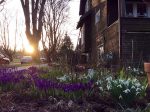(photo by Cynthia Ramsay)
With the skyrocketing Vancouver real estate prices the talk of Canadian news media almost daily, less attention has been given to the fate of the many homes whose high property price-tags all but encourage demolition and rebuilds.
One Facebook group has been seeking to draw attention to the disappearing streetscape of Vancouver. With 10,000 followers, Vancouver Vanishes bills itself as “a lament for, and celebration of, the vanishing character homes in Vancouver.” Some houses – like one on West 15th, originally owned by an assistant salesman for the Canadian Pacific Railway – have already met their fate. Others are slated for demolition, with photos posted in the hopes that followers will register their protest with Vancouver City Council.
My late grandfather’s home – on Fremlin Street near West 54th Avenue – was recently torn down to make way for a generous new build. Purchased with my grandmother and their three daughters in the late 1950s, my grandfather lived in his mid-century vernacular bungalow for nearly six decades, until he died three years ago at age 97.
While it was spacious and modern by 1950s standards, my grandfather’s house probably wouldn’t have made it to the pages of Vancouver Vanishes. It was a standard bungalow with four modest bedrooms, generous entertaining spaces, a kitchen large enough to accommodate Passover and everyday dishes, and a spacious rec room with a wet bar for teenage dance parties hosted by my mom and aunts. With more room to spread out, it would have felt excitingly large to the three daughters and, soon, another girl they fostered, compared to the small character home on Quesnel Drive from which they had moved. But theirs wasn’t among the most celebrated Vancouver “heritage home” variety – the Storybook homes, or the Tudor, Georgian or Mission Revival structures.
Still, the Jewish community may want to pause to consider a special type of vanishing as more and more of these homes disappear. That is, the kind of community-building that took place within the four walls of my grandparents’ home, and in the homes of many other community leaders and activists of their generation.
In my grandparents’ home on Fremlin, there was organizing and affiliation with Schara Tzedeck Synagogue, then under the leadership of Rabbi Bernard Goldenberg and Rabbi Marvin Hier. As well, with three growing daughters, there were the activities of many youth groups: NCSY, Young Judea and Habonim. There was the founding and nurturing of Camp Miriam, where my grandmother was the first “camp mother.” There was much work to be done for Pioneer Women, for the Histadrut (Israel’s trade union association) and in the preparation of a weekly radio show my grandparents hosted on Jewish and Israeli themes. In between the many hours devoted to volunteer work, there were their small businesses to run – Clifford’s Jewellers in Kitsilano, and their real estate ventures.
Plus, there were Sunday waffle brunches for the large extended Margolis family – whose members had found their way to Vancouver starting in the 1940s after arriving in Winnipeg from Kiev two decades earlier – and visitors from Russia and Israel.
With their three daughters spread across Vancouver Talmud Torah, Kitsilano, Churchill and Eric Hamber secondary schools, there was a home library to nurture, classical music records to collect, family photos to display and a garden to tend: irises, tiger lilies, azaleas, rhododendrons, peonies and hydrangeas, and fruit trees – apple, pear and cherry.
By the time I was around, spending one memorable summer in the orange bedroom in the late 1970s, there were memories for me to make – like suffering my first wasp sting on the back patio – and hobbies for me to discover: there was a teach-yourself-to-type book and a learn-to-speak Spanish book to read, all while I took up tennis in the shadow of my grandmother’s formidable court skills. By Grade 8, having moved to Vancouver with my parents from Winnipeg, there were weekly dinners prepared for me by my grandfather between my school day at Eric Hamber and my Judaic studies classes at Congregation Beth Israel and at the home of Rabbi Daniel Siegel.
What is lost when a mid-century Vancouver bungalow is demolished? Wood siding, stucco, a large picture window, a tiled porch and a garden lovingly tended. But for communities, there is so much more: memories forged of childrearing, philanthropy and leadership. Luckily for Vancouver’s Jewish community, while the building materials of these homes may be gone, the scaffolding of a vibrant community – generations later – remains.
Mira Sucharov is an associate professor of political science at Carleton University. She is a columnist for Canadian Jewish News and contributes to Haaretz and the Jewish Daily Forward, among other publications.

